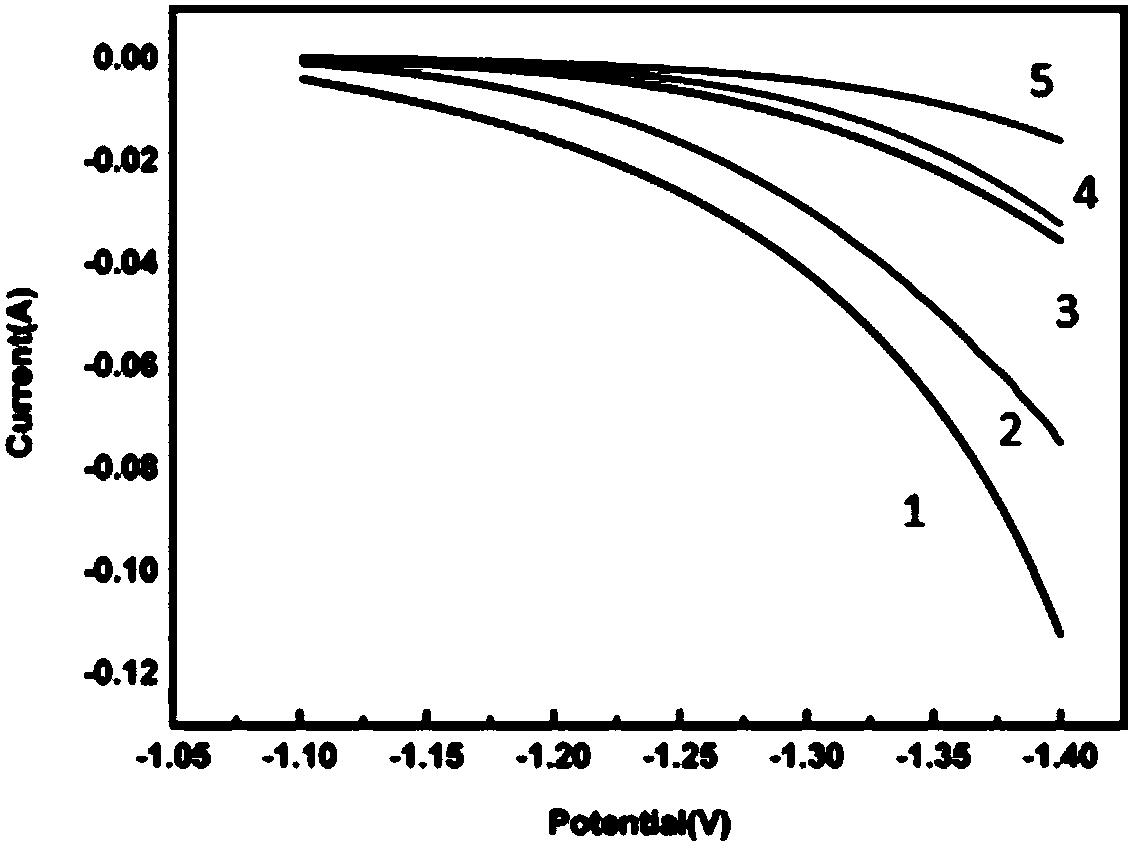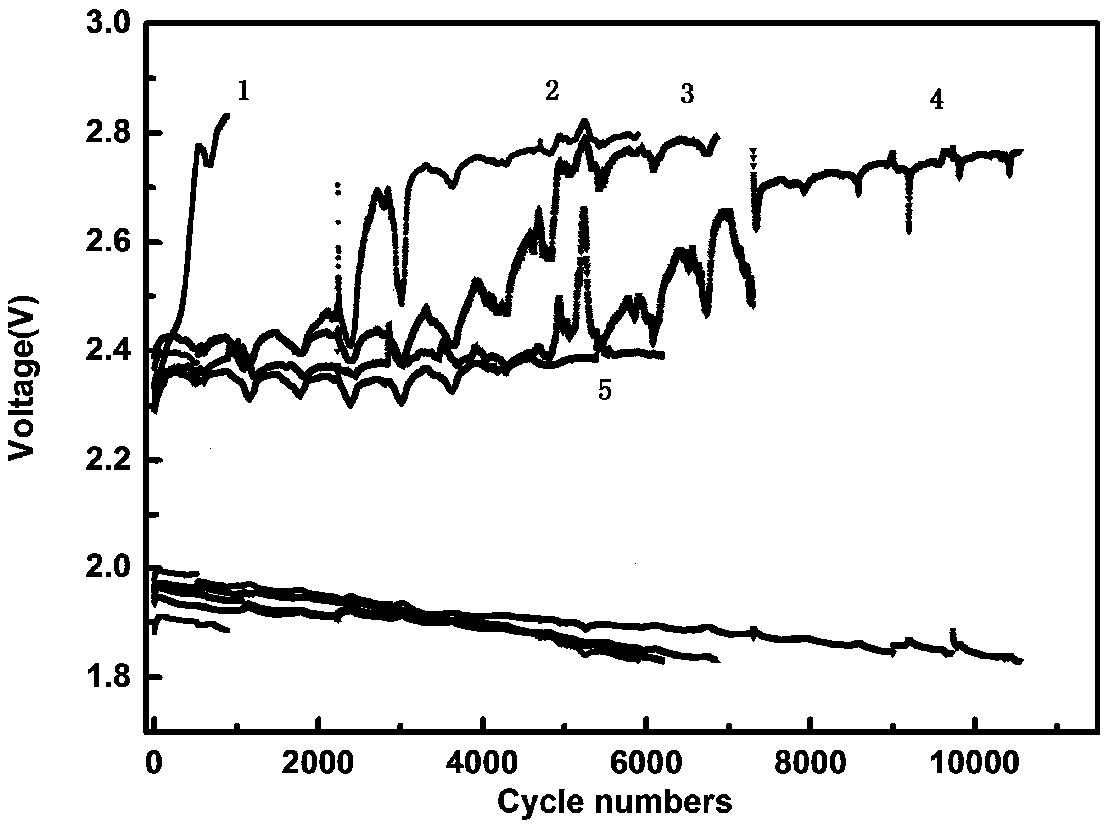Preparation method of carbon-based additive used for lead-carbon negative electrode
An additive and carbon-based technology, applied in lead-acid battery electrodes, battery electrodes, lead-acid batteries, etc., can solve the problems of severe hydrogen evolution reaction, uneven lead-carbon materials and pastes, etc.
- Summary
- Abstract
- Description
- Claims
- Application Information
AI Technical Summary
Problems solved by technology
Method used
Image
Examples
Embodiment 1
[0025] Take 3g of activated carbon, infiltrate in 20mL, 10wt.% sulfuric acid, wash and filter, then infiltrate, wash and filter with deionized water. Add 20mL of the treated carbon material, 5wt.% tin protochloride solution, stir for 1 hour, wash and filter, add 10mL, 0.0625wt.% palladium chloride solution, stir for 1 hour, wash, filter, and the treated The carbon material was put into 20mL DMSO solution containing 1.1g of thiourea and 4.8g of lead nitrate, and reacted at 60°C for 2 hours. Filter and dry overnight at 80°C to obtain a lead-carbon negative electrode carbon-based additive with a lead plating amount of 1.17wt.%.
[0026] Weigh 1Kg of lead powder, 1.3g of short fiber, 10g of barium sulfate, 2g of humic acid, 2g of sodium lignosulfonate, 3g of acetylene black and 20g of lead-carbon negative electrode carbon-based additives, dry mix for 30min, and then quickly add primary water 120mL, stirred for 10min, slowly added 58.86mL of 1.41g / mL sulfuric acid and stirred for ...
Embodiment 2
[0030] Take 3g of graphite, infiltrate in 20mL, 10wt.% sulfuric acid, wash and filter, then infiltrate, wash and filter with deionized water. Add 20mL of treated carbon material, 8wt.% stannous chloride solution, stir for 1 hour, wash and filter, add 10mL, 0.0725wt.% palladium chloride solution, stir for 1 hour, wash and filter, and the treated The carbon material was put into 20mL DMSO solution containing 2.2g thiourea and 9.6g lead nitrate, and reacted at 60°C for 2 hours. Filter and dry overnight at 80°C to obtain a lead-carbon negative electrode carbon-based additive with a lead plating amount of 2.11wt.%.
[0031]Weigh 1Kg of lead powder, 1.3g of short fiber, 10g of barium sulfate, 2g of humic acid, 2g of sodium lignosulfonate, 3.5g of acetylene black and 20g of lead-carbon negative electrode carbon-based additives, dry mix for 30min, and then quickly add a 120mL of water, stirred for 10min, slowly added 58.86mL of 1.41g / mL sulfuric acid and stirred for 30min, coated the...
Embodiment 3
[0035] Take 3g of activated carbon, infiltrate in 20mL, 10wt.% sulfuric acid, wash and filter, then infiltrate, wash and filter with deionized water. Add 20mL of the treated carbon material, 10wt.% tin protochloride solution, stir for 1 hour, wash and filter, add 10mL, 1wt.% palladium chloride solution, stir for 1 hour, wash and filter, and the treated carbon The material was put into 20mL DMSO solution containing 3.3g thiourea and 14.4g lead nitrate, and reacted at 60°C for 2 hours. Filter and dry overnight at 80°C to obtain a lead-carbon negative electrode carbon-based additive with a lead plating amount of 2.93wt.%.
[0036] Weigh 1Kg of lead powder, 1.3g of short fiber, 10g of barium sulfate, 2g of humic acid, 2g of sodium lignosulfonate, 4g of acetylene black and 20g of lead-carbon negative electrode carbon-based additives, dry mix for 30min, and then quickly add primary water 125mL, stirred for 10min, slowly added 58.86mL of 1.41g / mL sulfuric acid and stirred for 30min,...
PUM
 Login to View More
Login to View More Abstract
Description
Claims
Application Information
 Login to View More
Login to View More - R&D
- Intellectual Property
- Life Sciences
- Materials
- Tech Scout
- Unparalleled Data Quality
- Higher Quality Content
- 60% Fewer Hallucinations
Browse by: Latest US Patents, China's latest patents, Technical Efficacy Thesaurus, Application Domain, Technology Topic, Popular Technical Reports.
© 2025 PatSnap. All rights reserved.Legal|Privacy policy|Modern Slavery Act Transparency Statement|Sitemap|About US| Contact US: help@patsnap.com


